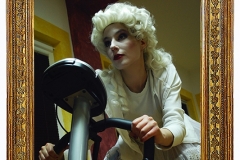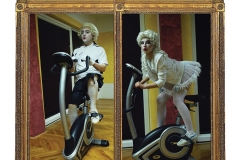Antoinette or the glamorous guillotine
Antoinette or the glamorous guillotine
Antoinette or the glamorous guillotine
What is so fascinating, intriguing and still irresistibly attractive in that “costumed period” of the 18th century?
The Baroque period, full of decor, kitsch and senseless hoarding, incredibly remind of the first decades of the new millennium as the embodiment of the power and hedonism of colonial forces, reappearing in a somewhat altered form, only three centuries later, as a result of the same human passions and lusts, this time, megalomaniacal, industrial production. The excess of gold, baroque ornaments in the past, the second half of the 20th century brings a false glow to the “glamorous” life obsessed with money. To be famous, rich, to be powerful, to own! Who will do more? Who will be faster? Who will go first? Everything can be bought, everything can be possessed, everyone has a price. Man becomes a commodity. Abundance of packaging, recycling … In the 18th, as well as in the 21st century, things culminate, reach their peak, the very absurdity, they burst.
In the search for a new formal system that could go beyond what is usual, the accent is placed on glamor and subsumed under the lifestyle. Marie Antoinette is a symbol of just such an action. It is the last stage of the constant accumulation of desires and attributes, the need to be immortal. The new modern is the new Rococo of the 21st century; the culmination of the capitalist race that shifted from product creation to information production, strengthening the link between power and knowledge. Without limit in speed and quantity, one wants everything and always more, as in cocaine addiction. The only boundary that can be set is death- cocaine overdose.
Milica Stojaković














